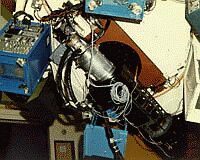Description: The optical
configuration consists of a lens, designed by Charles Wynne, which both
collimates the incoming beam from the telescope and refocusses the spectrum
after the nearly Littrow dispersion by the echelle grating. No
cross-dispersion is employed. The separate echelle orders, each containing
one or more nebular emission lines, are isolated with highly efficient,
three period interference filters. IPCS is the favoured detector, though
CCDs can be used with effect in certain applications.
This simple optical layout, transmission optics with three layer
anti-reflection coatings throughout and the quasi-Littrow configuration of a
reflection echelle grating, all combine to achieve an exceptionally high
luminosity-resolution product for the spectrometer. One penalty for this
optimization is the restriction to 3900-7500 Å of the operating
wavelength range.
The luminosity-resolution product is enhanced further for particular
astrophysical problems by having a variety of options for the entrance
slits. Either a single long slit or a multi-slit with up to five long slits
transmitting simultaneously are routinely employed. Separate file profiles
are obtained for each resolvable element along these slits. Where emission
and absorption line sources are distributed randomly within the entrance
aperture, multi-image masks, pre-arranged to accept the light from the
separate sources, can be used.
Six separate fibre arrays are assembled for use in the fibre mode (MATADOR).
Here the entrance of the fibres (with up to 529 being employed in one array)
are arranged to match the shapes of various sources in the focal plane of
the telescope. The output ends of the fibres are then distributed along up
to five entrance slits of the spectrometer.
In their primary mode the Manchester echelle spectrometers fill a distinct
niche between more traditional, cross-dispersed, echelle spectrometers,
which are primarily useful for small sources over very large wavelength
ranges, and the stepped Fabry-Perot devices such as TAURUS which are most
usefully applied to very extensive sources but over very small wavelength
ranges. The fibre-optic format changers extend the Manchester echelle´s
application to some extent into TAURUS territory.
The primary use of these dedicated echelle spectrometers is for problems
which require emission or absorption line profiles, at high signal to noise
ratios and reasonably high spectral resolutions, from many separate spatial
elements of a source simultaneously.
The imaging mode of the Manchester echelle spectrometers, which was
originally introduced as a minor alternative, has proved extraordinarily
useful in practice. Here the slit assembly is replaced by a clear aperture
and the plane mirror is inserted.
Time allocations:
Nights scheduled since semester 2007B
Research impact:
Publications (11 from ING paper count)
Multimedia:
Photo archive (1)



